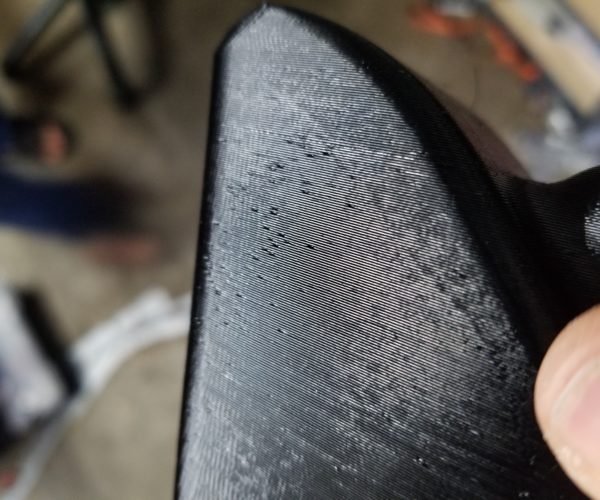Pock marks when printing larger
Hey all,
This is my first time posting here so let me know if I'm breaking any rules.
I'd like to ask for some advice on how to eliminate some pock marks.
Printer: MK3 with .5mm nozzle
Material: Esun PETG
Slicer: Simplify3D
Speed:2800mm/min
Temp:245-248
Layer height/width: .38mm/.6mm
The marks shown in the attached photo only occur when printing above .3mm height and seem to be a result of poor seam/retraction settings.
If there is any other info you need that may help, please let me know!
- Joe
RE: Pock marks when printing larger
You are printing at roughly 47mm/s * a 0.38mm layer height * a 0.6mm extrusion width. This gives an effective extrusion rate of roughly 10.7mm^3/s. Prusa rates most PETG filaments at closer to 8mm^3/s. Any faster and you risk outrunning the ability of the E3D V6 hotend to melt and move filament reliably. This could well explain the under-extrusion you're seeing. In short: Try slowing down. With those parameters, keep your speeds below 35mm/s (2100mm/m). I'd start at 25 and work up.
Unfortunately, Simplify 3D doesn't support a Maximum volumetric speed setting like PrusaSlicer, so you'll need to manually adjust your print speeds.
and miscellaneous other tech projects
He is intelligent, but not experienced. His pattern indicates two dimensional thinking. -- Spock in Star Trek: The Wrath of Khan
RE: Pock marks when printing larger
And the marks you are seeing are seams, nothing to do with extrusion rate. Change where seams are placed and you'll get better looking surfaces where you need them (I hide seams to the rear on curved parts).
ps: well, your second post shows you know they are seams... and seams can be cleaned up, but that will take a lot of tweaking. But K-factor, jerk, acceleration, z-lift, retraction, all of these interplay to make good seams.
RE: Pock marks when printing larger
@bobstro
It has been a while since I made this post, but your comment about max volumetric flow seemed to solve the problem!
RE: Pock marks when printing larger
It has been a while since I made this post, but your comment about max volumetric flow seemed to solve the problem!
Glad it helped. I always recommend slowing down when troubleshooting print quality issues. It's an easy way to determine if slicer settings will help. Using MVS is the easiest way to limit speeds with a single slicer setting, IMO.
and miscellaneous other tech projects
He is intelligent, but not experienced. His pattern indicates two dimensional thinking. -- Spock in Star Trek: The Wrath of Khan
